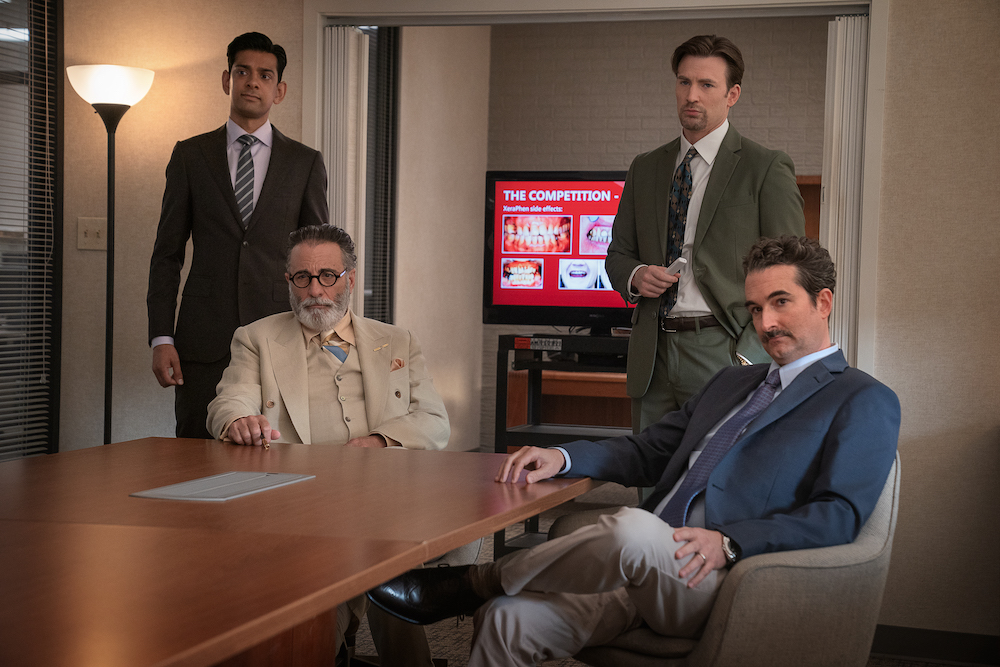Directed by David Yates, Netflix’s crime drama film ‘Pain Hustlers’ presents the ruthless side of the pharmaceutical industry and its relentless focus on making profits, no matter what impact their actions have on the lives of millions of people. The film begins with a woman named Liza Drake, who works at a strip club but soon lands a job as a pharma rep and becomes one of the major players in lifting the company out of its economic drudgery and turning it into one of the most profitable ventures.
‘Pain Hustlers’ is as shocking as it is entertaining, presenting a range of characters, most of whom walk on the darker side of the grey line. Considering that the events touch on the opioid crisis in America, it raises the question of how much the film relies on real events and people and how much truth is incorporated into it. Let’s find out. SPOILERS AHEAD
Pain Hustlers Draws Inspiration From a New York Times Article

‘Pain Hustlers’ is loosely based on the article of the same name and the book, ‘The Hard Sell: Crime and Punishment at an Opioid Startup’ by Evan Hughes, and follows the rise and fall of a company named Insys Therapeutics and its drug, Subsys. Hughes reported on the company’s shady practices in heightening the sales of the fentanyl-based drug and interviewed former employees who worked in sales and other departments to get to the root of the story.
Drawing from Hughes’ work, Wells Tower wrote the screenplay for the Netflix film and took a lot of creative liberties in turning the story into something more compact, which could fit into the two-hour narrative of a film. Because the filmmakers knew they couldn’t be faithful to every aspect of the story, they made many changes, like compositing several real people into one character and giving new names to the characters, the company, and the drug at the center of it all. “This isn’t the Insys story in detail at all. It’s inspired by that—the fringes of that industry and how they exploit one very marginal sector of the healthcare industry and make a fortune out of it,” director David Yates said in an interview with Time.
The True Story of Insys Therapeutics
In the movie, Jack Neel (played by Andy Garcia) is the head of a company called Zanna Therapeutics, focused on selling a drug called Lonafen. In real life, Insys Therapeutics was founded by a man named John Kapoor, who developed Subsys, reportedly motivated by his wife’s battle with metastatic breast cancer, which claimed her life in 2005. Kapoor wanted the drug to be a success, for which he brought together a team of highly dedicated people, which included a man named Alec Burlakoff, who is most likely the inspiration for Chris Evans’ character in the movie.
Burlakoff started as the head of sales and was known to hire people from all sorts of backgrounds to get them into pharma reps. According to the NYT article, he is known to have hired an exotic dancer to lure the doctors into prescribing more Subsys. The film uses this detail to create the fictional character of Liza Drake, played by Emily Blunt. With other company executives and sales reps across the country, the company reportedly resorted to illegal means, including bribing doctors to increase the sales of Subsys.

Reportedly, the company’s net revenue hiked to more than $95 million (more than 1000 percent) within a year. One of the main reasons behind this is said to be the “speaker program” that Insys leaned into. In general, speaker programs are used by pharma companies to bring doctors in to talk about their drugs, and it’s all pretty legal. But in Insys’ case, things took a more crooked turn because the programs were said to have been mostly just for show, and the doctors weren’t even required to give a speech or talk to anyone, though they were paid for the said appearance. In return for this easy money, all they had to do was to be continually loyal to Insys and keep writing prescriptions for Subsys.
According to the US Department of Justice, Kapoor authorized the speaker programs in 2012, which were “used as a vehicle to pay bribes and kickbacks to targeted practitioners in exchange for increased Subsys prescriptions and increased dosage.” Insys is said to have put around $10 million into the program, with the top ten speakers making anywhere around $200,000 or more. Additionally, the company was also accused of making its employees pose “as employees of the practitioner and used a script of false and misleading representations about patient diagnoses in order to secure approval for the drug by the insurance provider.”
Insys is also said to have pushed for the use of Subsys beyond its primary function, which was intended to help cancer patients. With more and more doctors prescribing Subsys for pain other than cancer, things soon got out of hand, and the cases of addiction spiked. Eventually, several employees at the company decided not to do it anymore and reported against their employers, which led to an investigation, with almost all major executives, including Kapoor, getting arrested and convicted for their crimes.
‘Pain Hustlers’ captures the essence of this real story through a fictional approach. In the real-life case, there are a number of factors and people that added to the narrative, which would have been difficult to encapsulate in a two-hour runtime. So, the filmmakers decided to narrow down a few things so that the soul of the story remains in place even if it receives a fictional touch.
Read More: Where is Pain Hustlers Filmed?


You must be logged in to post a comment.